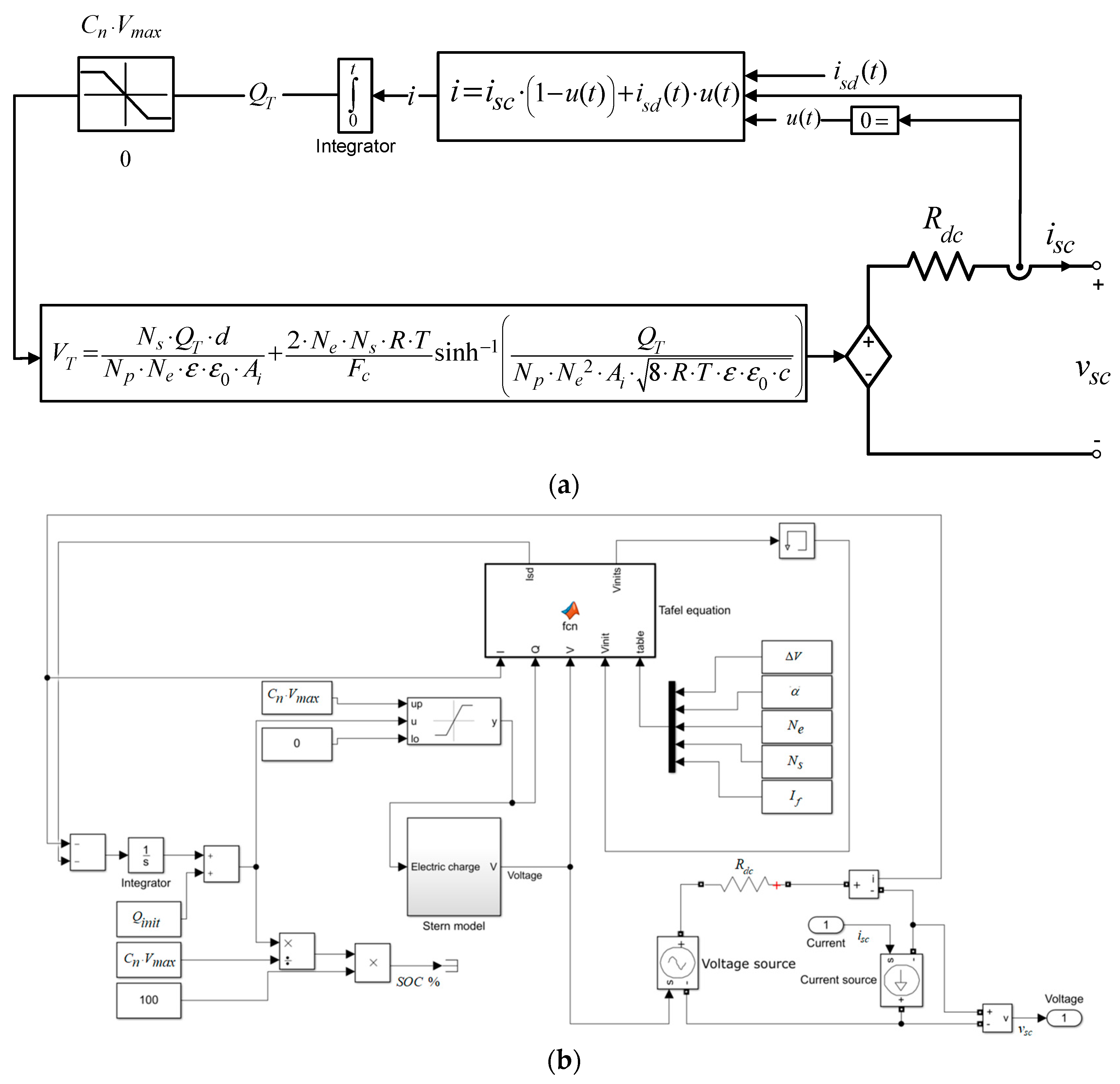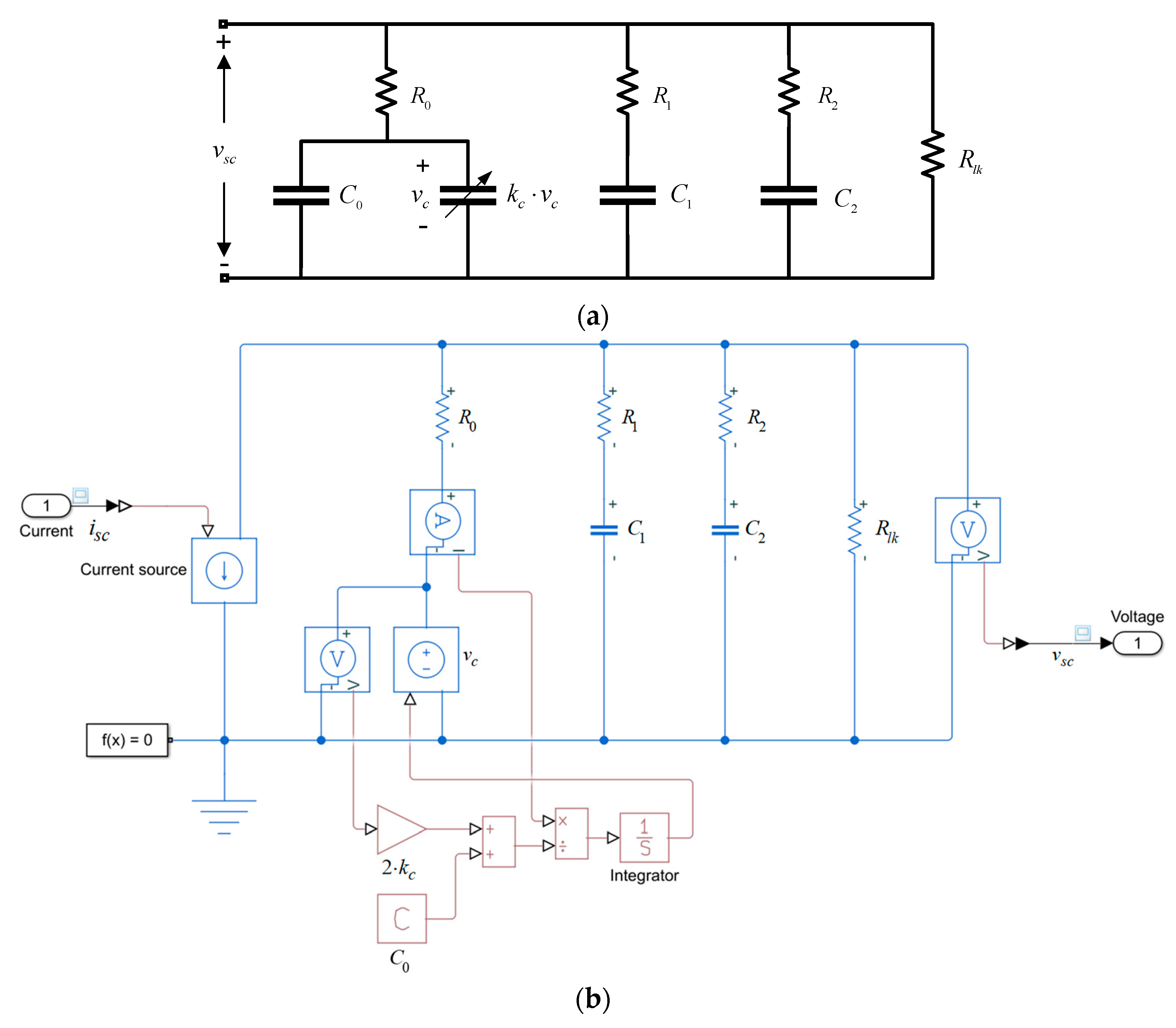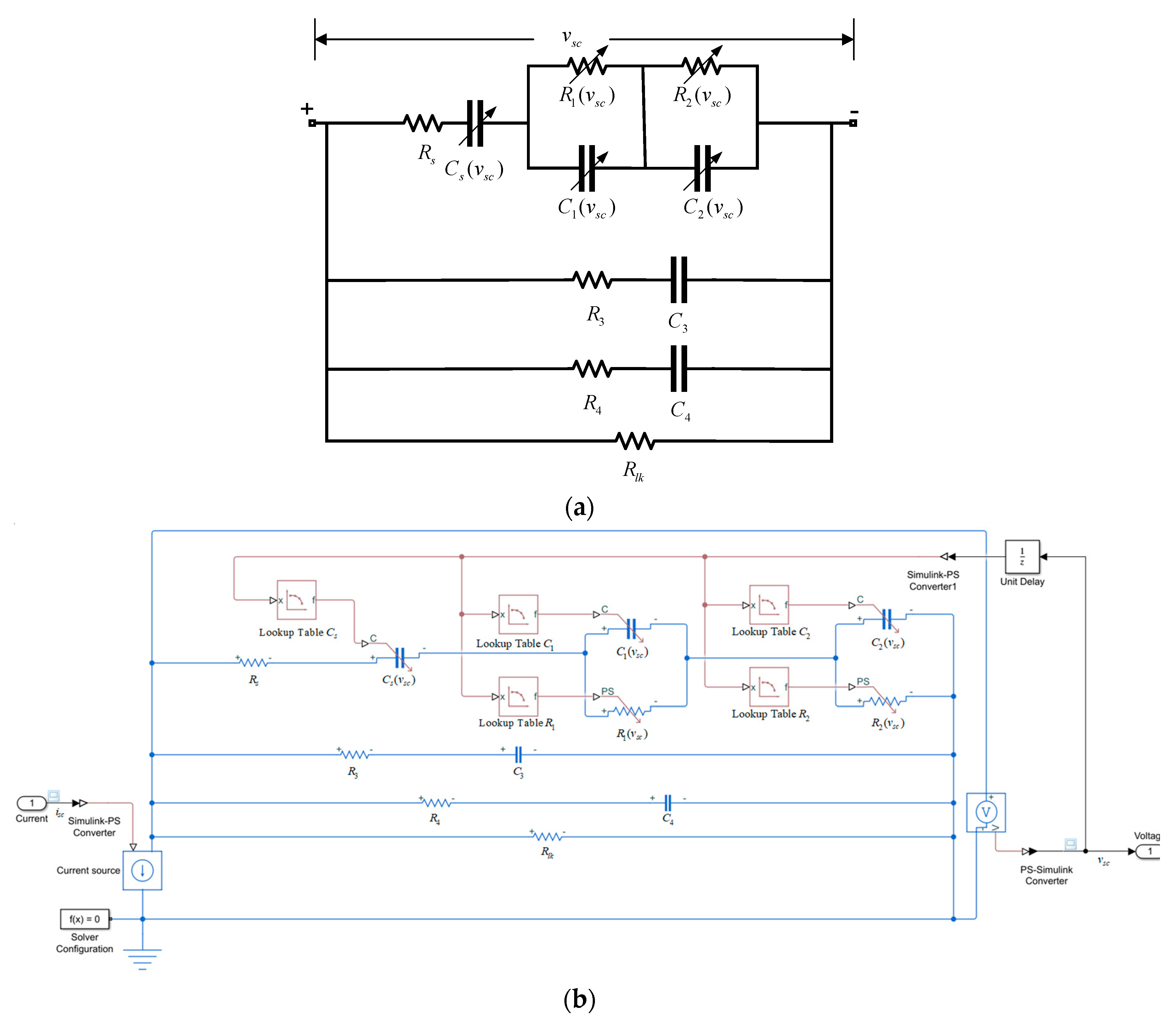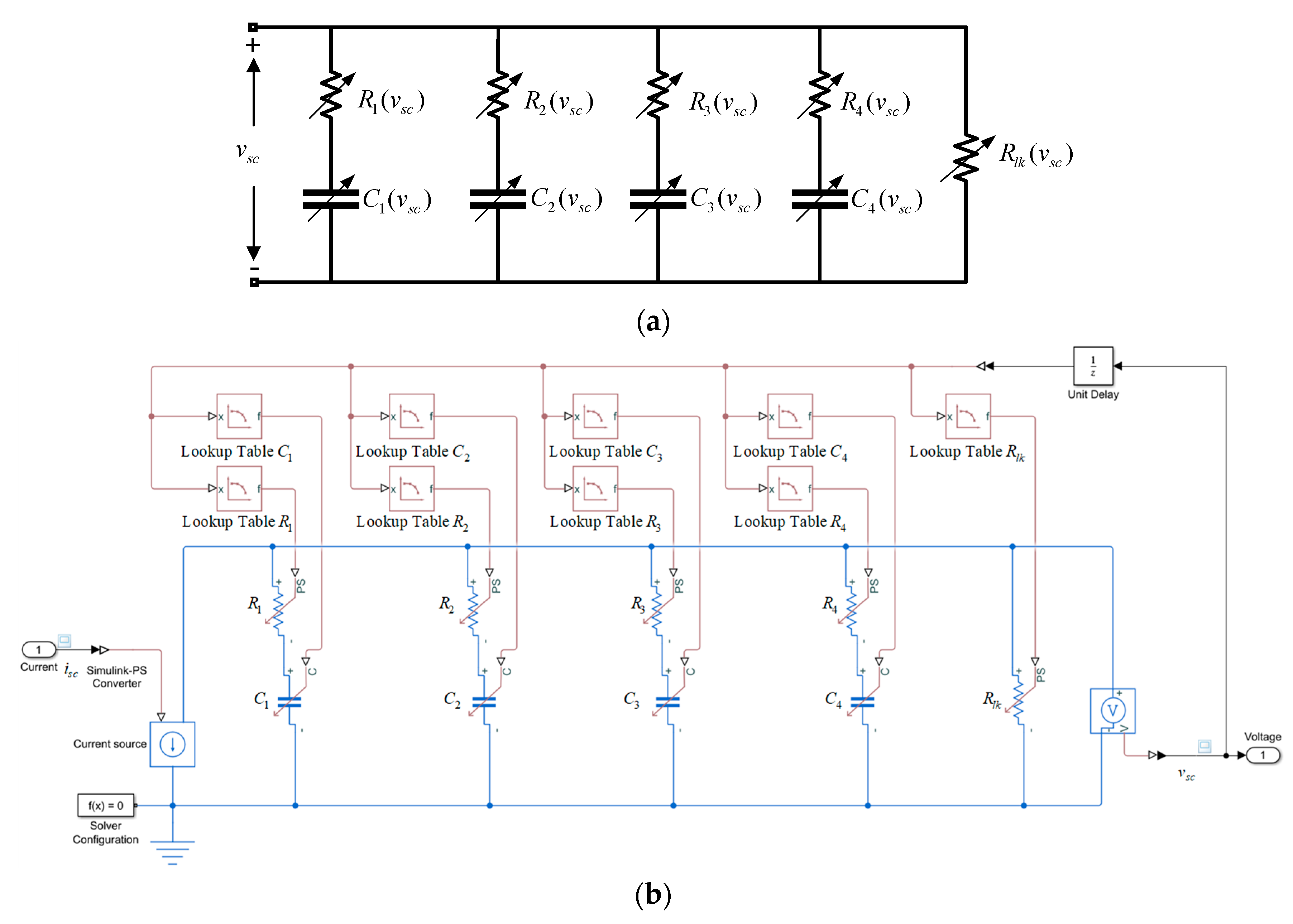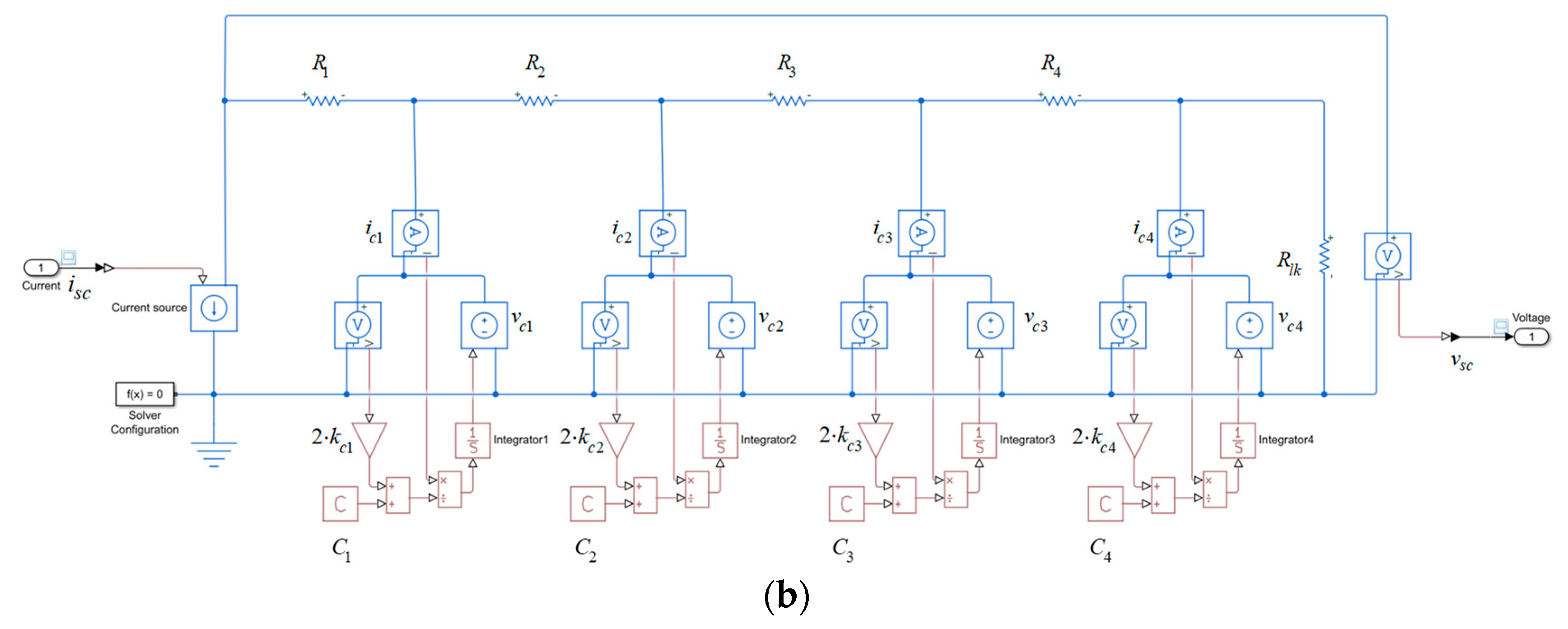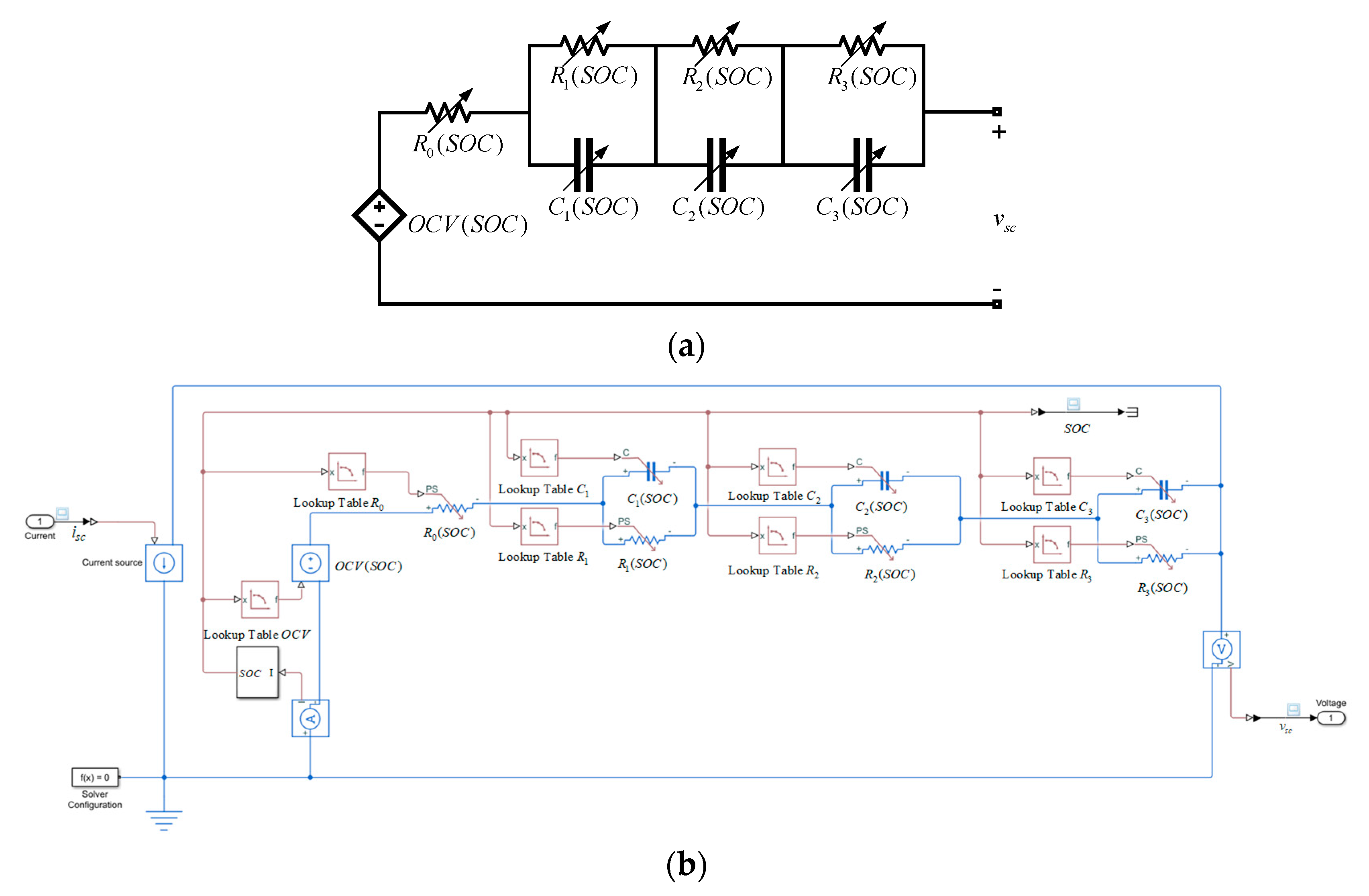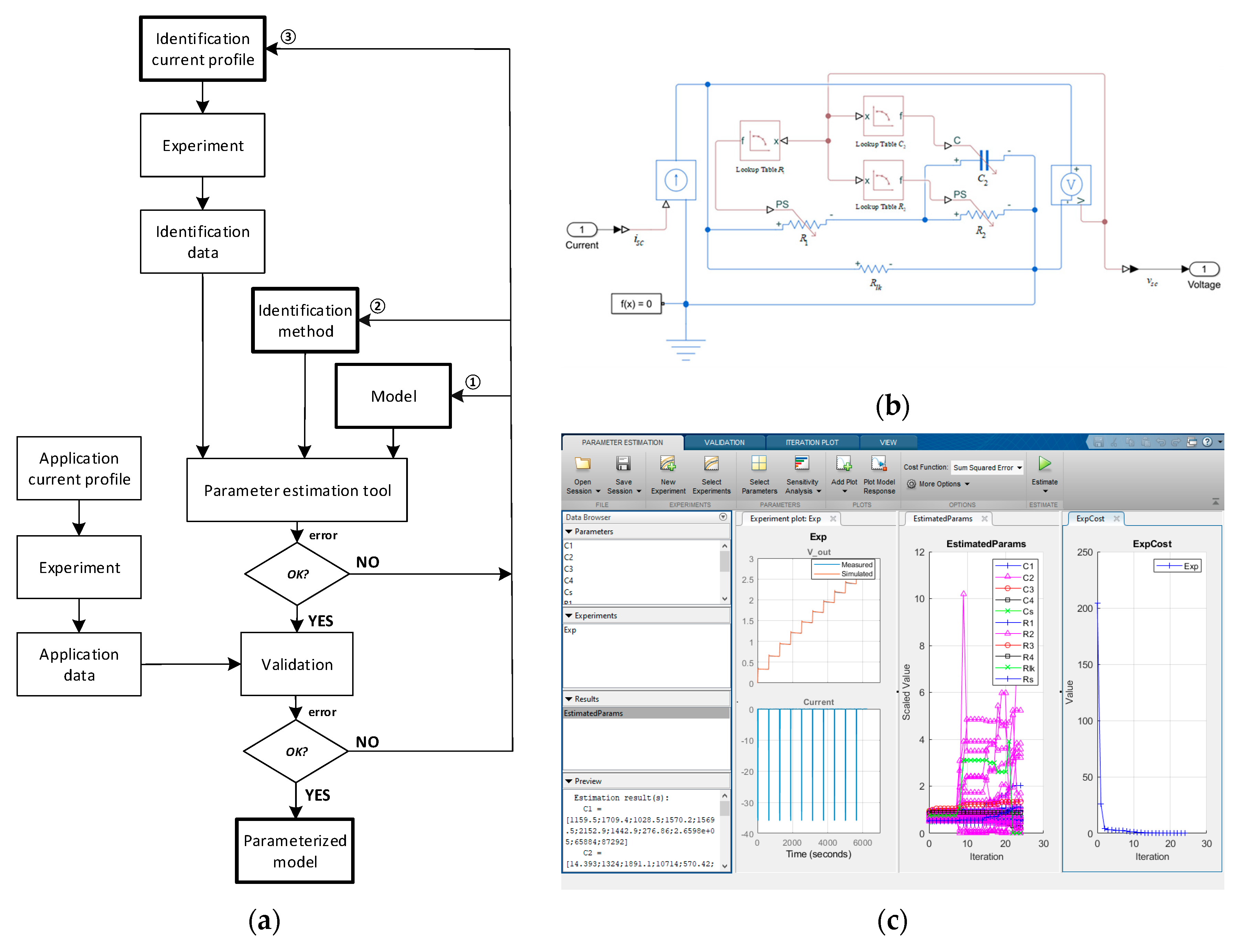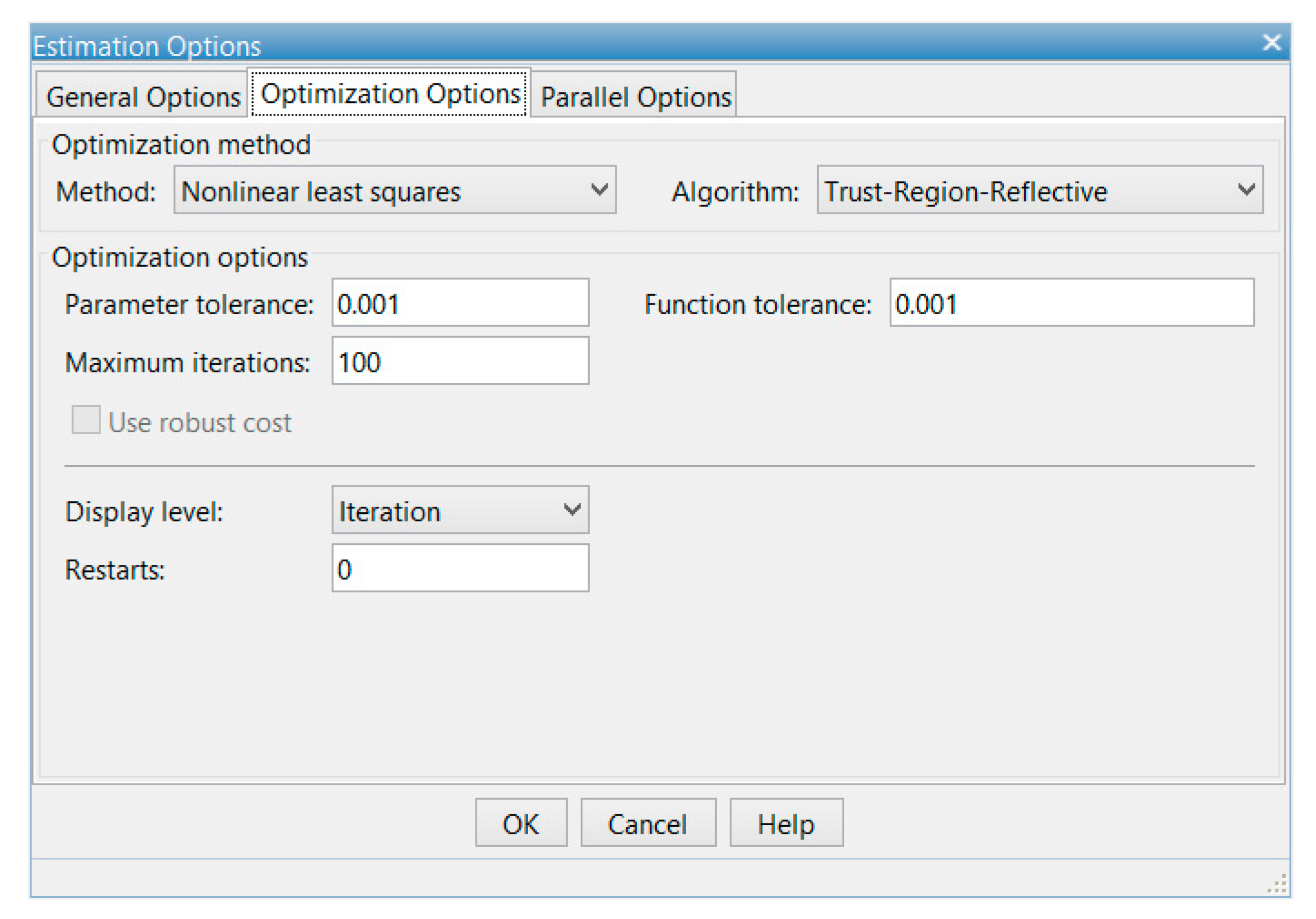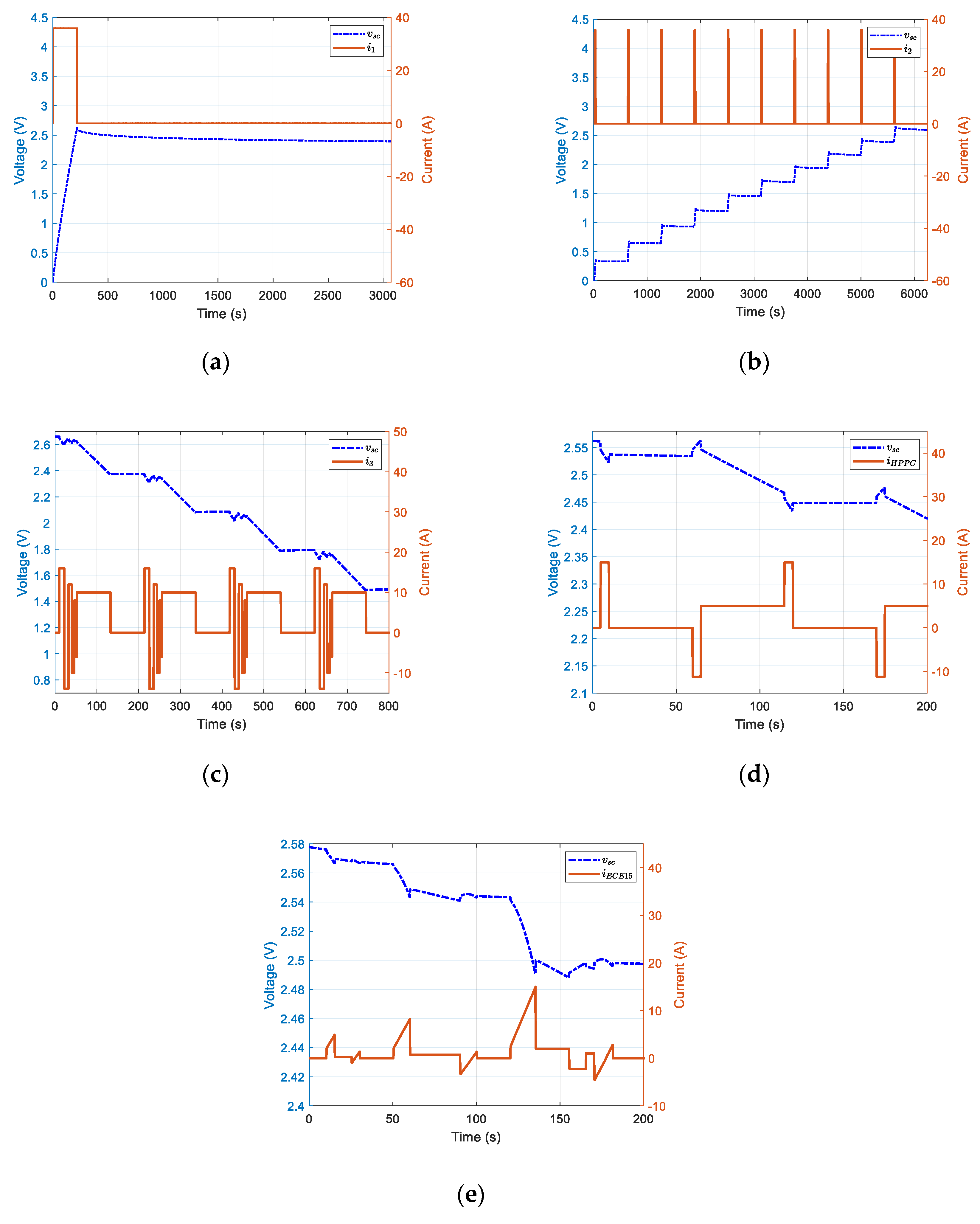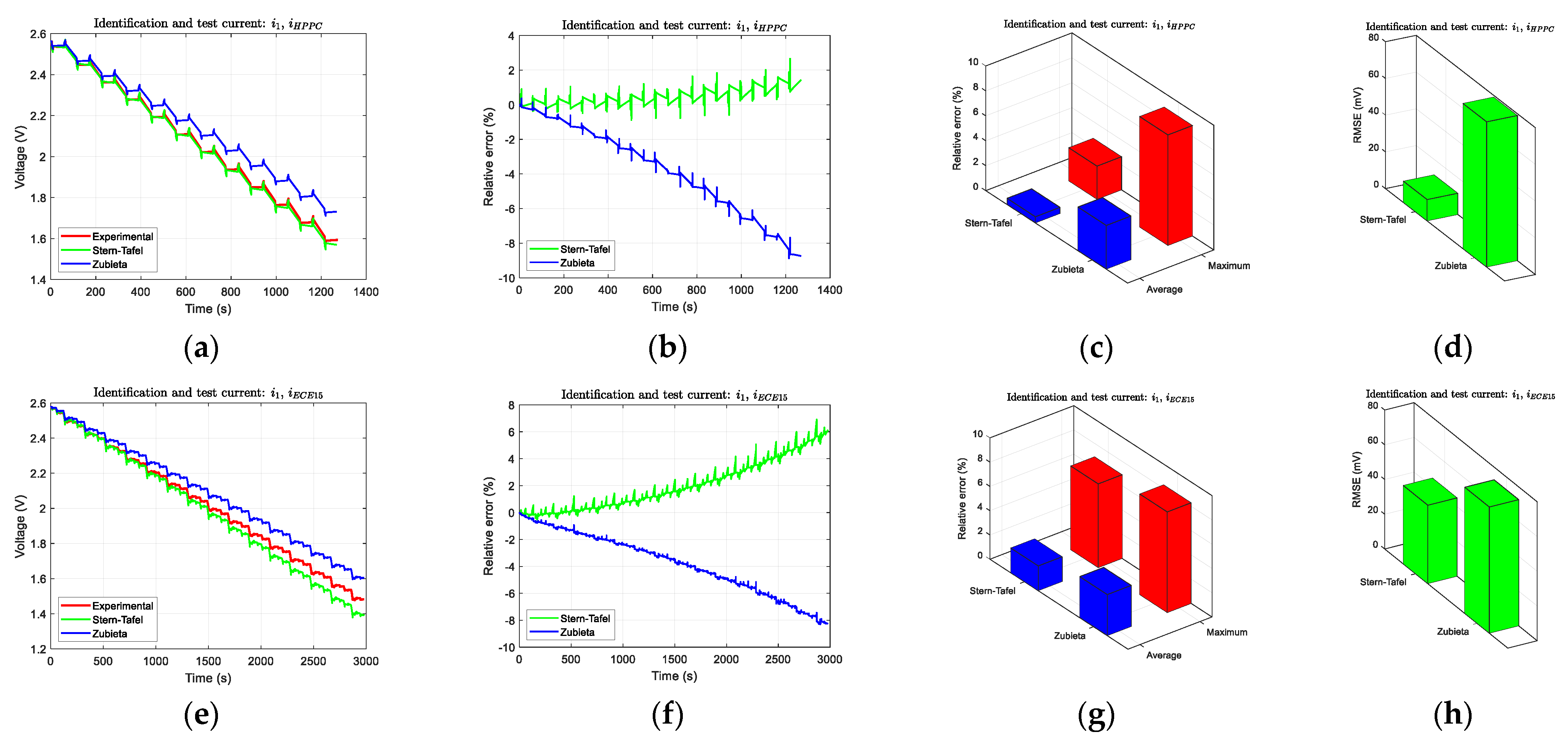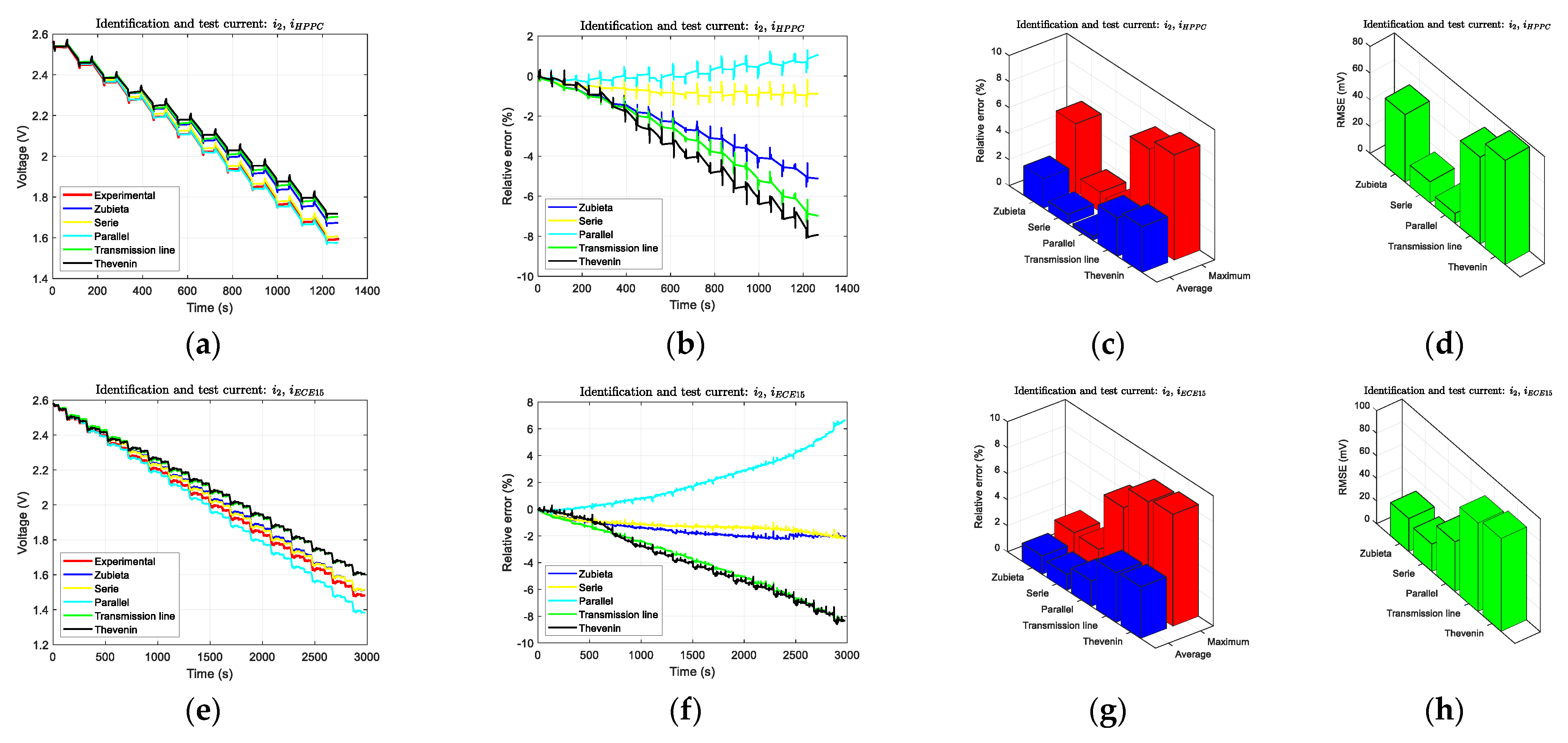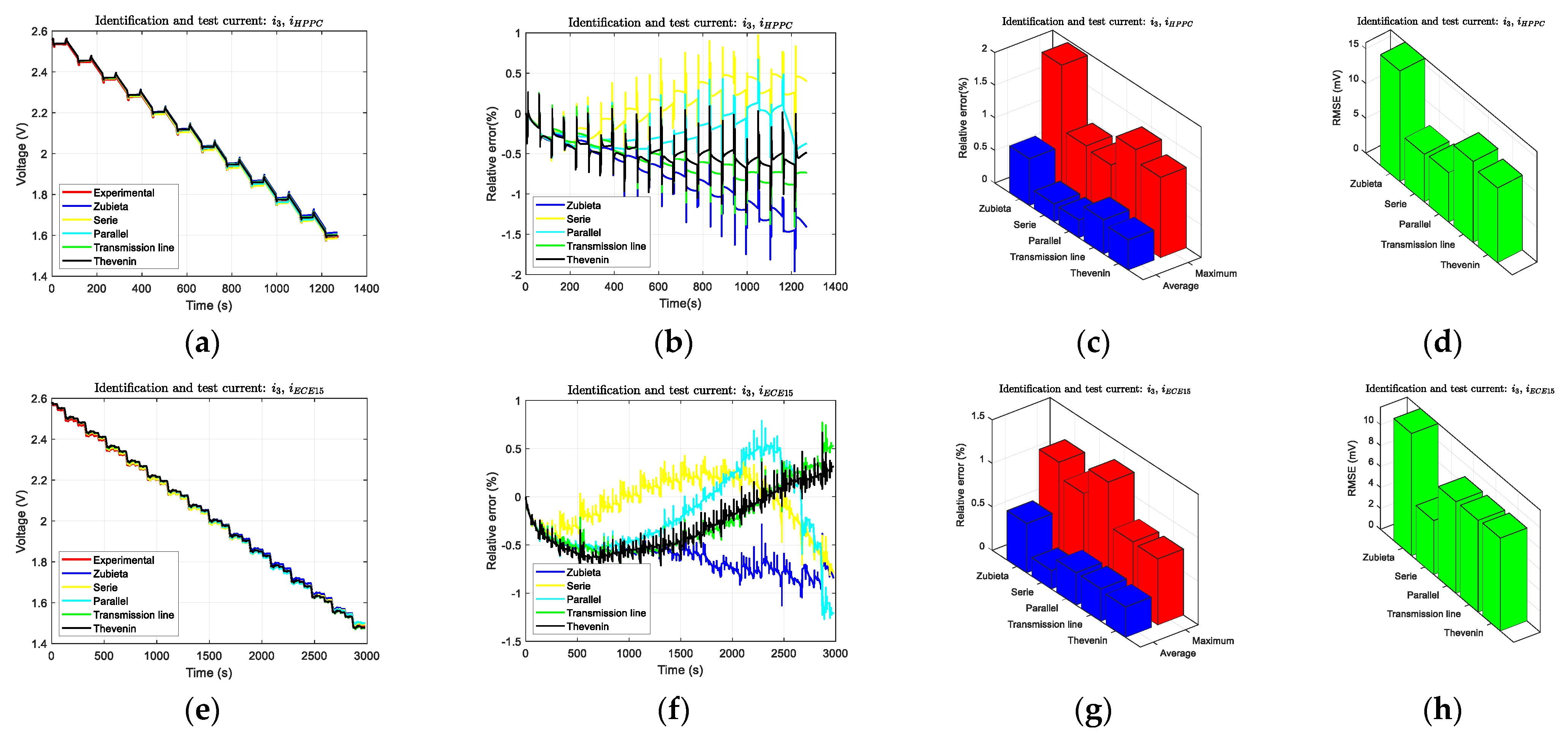1. Introduction
Energy storage systems are essential in the industrial, medical, renewable or transportation sectors, as well as other sectors. Some characteristics like high power density, reliability and safety are critical in those sectors, this is why the electrochemical double layer capacitor or the supercapacitor play an important role [
1].
Many application areas in which supercapacitors are used can be mentioned like magnetic resonance imaging (MRI) that needs very short pulses with high current [
2] or fuel cell supercapacitor hybrid bus, where the supercapacitor satisfy the dynamic power demand [
3]. In addition, the supercapacitor can be used for the integration of a photovoltaic power plant [
4], grid integration of renewable energies [
5] and the improvement of energy utilization for mine hoist applications [
6]. However, many applications are limited by the self-discharge behavior in wireless sensor network applications [
7], where the new techniques of chemical modification to suppress this phenomenon are shown in reference [
8] and reference [
9].
In general, the supercapacitors models classify into three categories: electrochemical, mathematical, and electrical. Electrochemical models consist of a set of partial differential-algebraic equations with many parameters. The estimation of the electrochemical model is very accurate [
10]. However, the simulation of these models consumes many resources. Mathematical models are an alternative based on three dimensional ordered structures [
11]. It can get a good fitting with experimental data but with a complex process to get the different parameters. Finally, circuit-based or electrical models are able to reproduce the electrical behavior of supercapacitors with equivalent circuits [
12].
In the literature, there are some studies comparing supercapacitor models. Reference [
13] reviews three types of equivalent circuits with linear components, with only an identification current profile and several verification current profiles. These models are the classic model, the multi-stage ladder model, and the dynamic model, which are used in electric vehicle applications. In this case, a genetic algorithm (GA) is used to estimate the different constant parameters of the resistors and capacitors (
RC) circuits. Reference [
14] analyzes three basic constant parameters RC networks models showing the relationship among them. However, as shown in reference [
15], the model accuracy can be improved with a nonlinear equivalent circuit model. In reference [
16], the authors compared three circuits models (Miller Model, Zubieta Model, and Thevenin Model) with a specific identification current profile for every model. In general, the papers found in the state-of-the-art compare some of the known supercapacitor models, applying different identification current profiles, and using different parameters identification procedures, as it is difficult to obtain reliable conclusions to identify the best model for every application.
The main contribution of this paper is the proposal of a general, practical and effective parameters identification procedure applied to supercapacitors models and obtained in offline mode. The parameters of this model can also be used as an initial estimation of the parameters in online supercapacitor models [
17]. The numeric optimization is developed by means of the interactive interface provided by the Identification Toolbox of Matlab (Version R2018b, MathWorks, Natick, MA, USA), once the equivalent models are built in Simulink or Simscape. In addition, the paper shows the comparison of different identification current profiles applied to six kinds of models in order to obtain the best features of each model, as well as the best accurate vs. complexity model.
The next sections are organized as follows:
Section 2 shows the six supercapacitor models selected to make the comparative study, as well as their circuits implemented in Simulink or Simscape.
Section 3 describes the parameters estimation procedure.
Section 4 depicted the different current profiles and the experimental setup to get the supercapacitor voltage and current responses.
Section 5 shows the obtained statistical metrics using ECE15 and HPPC dynamic driving cycles, and the discussion about the experimental vs. simulation results. Finally, in
Section 6, the main conclusions are presented.
3. Parameters Estimation Procedure
Parametric models explicitly contain differential equations, transfer function or block diagrams. The parameters update could be offline or online. For obtaining the parameters, in the offline mode, the data are stored to later process, on the other hand, in the online mode, the procedure is executed in parallel to the experiment [
43]. In the literature, there are many proposed procedures to obtain the model parameters such as e.g., the unscented Kalman filter [
44] or the Luenberger-style technique [
17].
Taking into account the literature, this paper focuses on the proposal of a practical, interactive, simple and enough general offline procedures for estimating the model parameters.
Figure 7a shows the proposed identification procedure block diagram. This procedure can be divided into several steps, shown and described in
Table 1.
In step 5, the optimization method has to be selected. This paper uses an offline parameters estimation based on the error minimization between the measured and simulated supercapacitor voltage. The iterative procedure tunes the supercapacitors model parameters (
p) to get a simulated response (
Vs) that tracks the measured response (
Vm), with a finite number of samples (
n). To do that, the solver minimizes the next cost function for each current profile:
where
p varies between zero and infinity (e.g., 0 to 10
10).
The minimization problem is carried out with Simulink
® Design Optimization™ of Matlab (Version R2018b, MathWorks, Natick, MA, USA). This toolbox provides an interactive interface that helps to minimize the square of the error between the measured and simulated supercapacitor voltage, using the nonlinear least squares method for parameters estimation. This method is selected in the user interface as shown in
Figure 8.
This method uses the Simulink function named as lsqnonlin, that requires at least (2
k + 1) simulations per iteration, where
k is the number of parameters to be estimated [
46]. The required CPU time and memory increase as a function of the numbers of parameters and their initial values. The offline runtime estimation is in the order of minutes.
If runtime estimation has to be reduced, other techniques based on the layered technique to break the global optimization into a smaller task [
47], or based on differential mutation strategy [
48], or based on genetic programming [
49], among others, could be used, although the flexibility and simplicity provided by the Simulink user interface could be affected.
On the other hand, the algorithm selected is the Trust-Region-Reflective, which is based on a gradient process with a trial step by solving a trust region. Specific details of the algorithm can be found in reference [
45]. Additional information is detailed in reference [
50], in which the process of how to import, analyze, prepare and estimate model parameters in Simulink is described.
Using the proposed procedure, based on Simulink® Design Optimization™ of Matlab, the most model can be built, from a practical point of view. Nevertheless, this procedure is limited by the optimization methods and algorithms included in Simulink.
5. Experimental Results, Comparison, and Discussion
After obtaining the parameters for each model, detailed in
Appendix A in
Table A1,
Table A2,
Table A3,
Table A4,
Table A5,
Table A6,
Table A7,
Table A8 and
Table A9, using the procedure described in
Section 3 and identification current profiles described in
Section 4, the output voltage accuracy and robustness analysis for the six supercapacitor models described in
Section 2 is performed based on statistical metrics, such as relative error and root-mean-square (RMS) error.
Comparative results with identification current profile
i1 are illustrated in
Figure 11a–d for the HPPC test and
Figure 11e–h for the ECE15 test.
Figure 11a,e show the experimental supercapacitor voltage and the voltages provided by the Stern-Tafel and Zubieta models.
Figure 11b,f show the relative error between these models and the experimental data.
Figure 11c,g represent the relative error in percentage.
Figure 11d,h show the RMS error in mV. It shows that the Stern-Tafel model has lower error values in comparison with the Zubieta model. In any case, the relative error tendency with the time increase in both models, therefore the accuracy of both models identified with the
i1 current profile is not proper.
Similar information is shown when current profile
i2 is used to obtain the model parameters.
Figure 12a–d depicted the obtained result for the HPPC test and
Figure 12e–h for the ECE15 test. This current profile is applied to five out of the six models, with the exception of the Stern-Tafel model. In this case, the Series model is the best one, since it presents a reduced relative error that maintained with the time.
Finally, the result obtained with the current profile
i3, which is the most dynamic current profile, is depicted in
Figure 13a–d for the HPPC test and
Figure 13e–h for the ECE15 test. This current profile has been applied to the same models as current profile
i2. Again, the Serie Model has the best performance, and even the obtained relative error is lower than using the previous current profiles. Nevertheless, the Parallel model, Transmission Line model and Thevenin model get good behaviors.
The main conclusions obtained from these results are the following:
The greater complex identification current profile i3 gets greater accuracy for every model in which it can be applied.
In most cases, the Series model provides the minimum relative error.
If a simple and basic supercapacitor model has to be used, the best option is to use Zubieta model identified with the current profile i3.
6. Conclusions
This paper describes a parameter identification general procedure with a flexible and interactive interface used to build supercapacitor models in Simulink or Simscape. This procedure enables estimating the different models parameters based on the use of the Optimization Toolbox of Matlab®. Once, the procedure steps are explained, the procedure is used to develop a comparative study of six commonly used supercapacitor models. In addition, the procedure enables using different identification current profiles, providing the possibility of analyzing the influence of three different identification current profiles in the accuracy and robustness of every model.
The experimental results obtained from the six models and three different identification current profiles, used to develop the study, show that both the model and the identification current profile are critical to obtaining good accuracy and robustness, which must be maintained over time.
From the comparison between the experimental results and the simulation results obtained using the model, it can be concluded that the greater complexity of the current identification profile, the greater accuracy and robustness of the model. In this case, the most complex identification current profile i3 gets the best accuracy for every model in which it can be applied.
In a short simulation period, most models provide enough accuracy results. However, in a long simulation period the differences among models as well as among the current identification profiles increase, and models responses cumulate voltage errors and, in some cases, they cannot correctly represent the voltage of the supercapacitor. The Stern-Tafel model is proper for a short simulation and as a first approximation. However, in a long-time simulation, the Series Model represents a good performance, followed by the Parallel Model. In most cases, the Series model provides the minimum relative error. However, the Zubieta model provides a good compromise between complexity and accuracy. Then, if a simple and basic supercapacitor model has to be used, the best option is to use a Zubieta model identified by means of the current profile i3.
